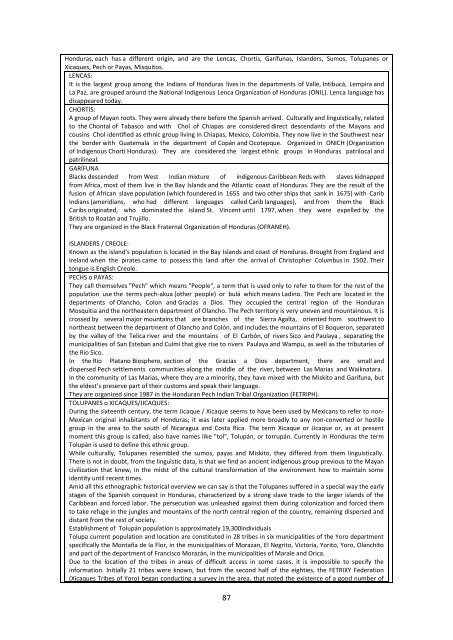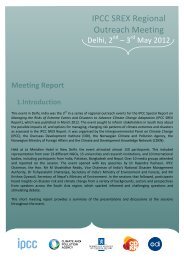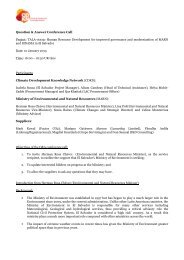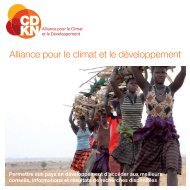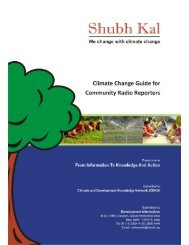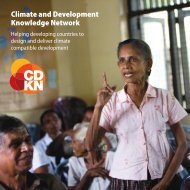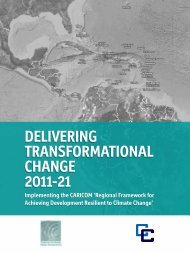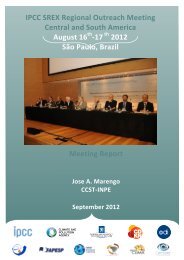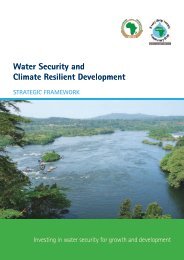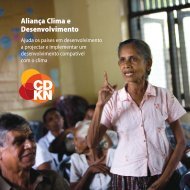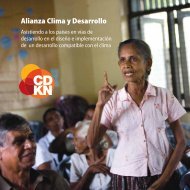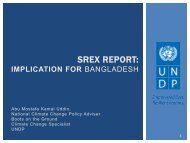Harmonized Perspectives - CDKN Global
Harmonized Perspectives - CDKN Global
Harmonized Perspectives - CDKN Global
- No tags were found...
Create successful ePaper yourself
Turn your PDF publications into a flip-book with our unique Google optimized e-Paper software.
Honduras, each has a different origin, and are the Lencas, Chortis, Garífunas, Islanders, Sumos, Tolupanes orXicaques, Pech or Payas, Misquitos.LENCAS:It is the largest group among the Indians of Honduras lives in the departments of Valle, Intibucá, Lempira andLa Paz, are grouped around the National Indigenous Lenca Organization of Honduras (ONIL). Lenca language hasdisappeared today.CHORTIS:A group of Mayan roots. They were already there before the Spanish arrived. Culturally and linguistically, relatedto the Chontal of Tabasco and with Chol of Chiapas are considered direct descendants of the Mayans andcousins Chol identified as ethnic group living in Chiapas, Mexico, Colombia. They now live in the Southwest nearthe border with Guatemala in the department of Copán and Ocotepque. Organized in ONICH (Organizationof Indigenous Chorti Honduras). They are considered the largest ethnic groups in Honduras patrilocal andpatrilineal.GARÍFUNABlacks descended from West Indian mixture of indigenous Caribbean Reds with slaves kidnappedfrom Africa, most of them live in the Bay Islands and the Atlantic coast of Honduras. They are the result of thefusion of African slave population (which foundered in 1655 and two other ships that sank in 1675) with CaribIndians (ameridians, who had different languages called Carib languages), and from them the BlackCaribs originated, who dominated the island St. Vincent until 1797, when they were expelled by theBritish to Roatán and Trujillo.They are organized in the Black Fraternal Organization of Honduras (OFRANEH).ISLANDERS / CREOLE:Known as the island's population is located in the Bay Islands and coast of Honduras. Brought from England andIreland when the pirates came to possess this land after the arrival of Christopher Columbus in 1502. Theirtongue is English Creole.PECHS o PAYAS:They call themselves "Pech" which means "People", a term that is used only to refer to them for the rest of thepopulation use the terms pech-akua (other people) or bulá which means Ladino. The Pech are located in thedepartments of Olancho, Colon and Gracias a Dios. They occupied the central region of the HonduranMosquitia and the northeastern department of Olancho. The Pech territory is very uneven and mountainous. It iscrossed by several major mountains that are branches of the Sierra Agalta, oriented from southwest tonortheast between the department of Olancho and Colón, and includes the mountains of El Boqueron, separatedby the valley of the Telica river and the mountains of El Carbón, of rivers Sico and Paulaya , separating themunicipalities of San Esteban and Culmí that give rise to rivers Paulaya and Wampu, as well as the tributaries ofthe Rio Sico.In the Rio Platano Biosphere, section of the Gracias a Dios department, there are small anddispersed Pech settlements communities along the middle of the river, between Las Marias and Waiknatara.In the community of Las Marias, where they are a minority, they have mixed with the Miskito and Garifuna, butthe eldest’s preserve part of their customs and speak their language.They are organized since 1987 in the Honduran Pech Indian Tribal Organization (FETRIPH).TOLUPANES o XICAQUES/JICAQUES:During the sixteenth century, the term Jicaque / Xicaque seems to have been used by Mexicans to refer to non-Mexican original inhabitants of Honduras; it was later applied more broadly to any non-converted or hostilegroup in the area to the south of Nicaragua and Costa Rica. The term Xicaque or Jicaque or, as at presentmoment this group is called, also have names like "tol", Tolupán, or torrupán. Currently in Honduras the termTolupán is used to define this ethnic group.While culturally, Tolupanes resembled the sumos, payas and Miskito, they differed from them linguistically.There is not in doubt, from the linguistic data, is that we find an ancient indigenous group previous to the Mayancivilization that knew, in the midst of the cultural transformation of the environment how to maintain someidentity until recent times.Amid all this ethnographic historical overview we can say is that the Tolupanes suffered in a special way the earlystages of the Spanish conquest in Honduras, characterized by a strong slave trade to the larger islands of theCaribbean and forced labor. The persecution was unleashed against them during colonization and forced themto take refuge in the jungles and mountains of the north central region of the country, remaining dispersed anddistant from the rest of society.Establishment of Tolupán population is approximately 19,300individualsTolupa current population and location are constituted in 28 tribes in six municipalities of the Yoro departmentspecifically the Montaña de la Flor, in the municipalities of Morazan, El Negrito, Victoria, Yorito, Yoro, Olanchitoand part of the department of Francisco Morazán, in the municipalities of Marale and Orica.Due to the location of the tribes in areas of difficult access in some cases, it is impossible to specify theinformation. Initially 21 tribes were known, but from the second half of the eighties, the FETRIXY Federation(Xicaques Tribes of Yoro) began conducting a survey in the area, that noted the existence of a good number of87


